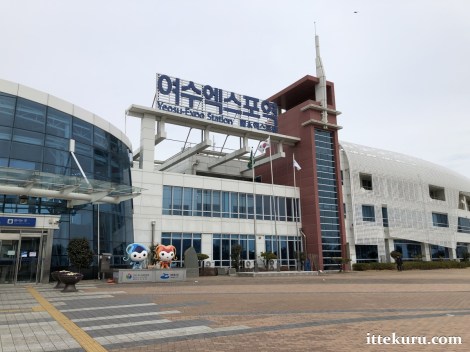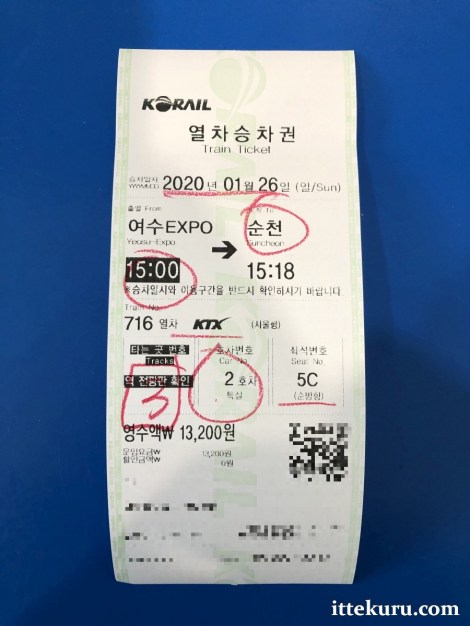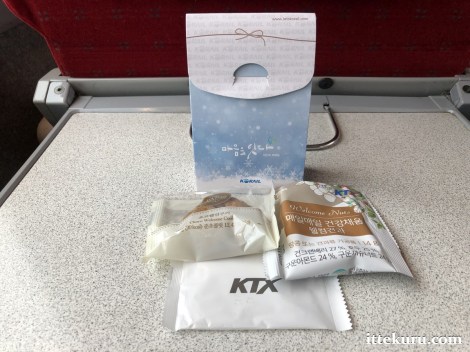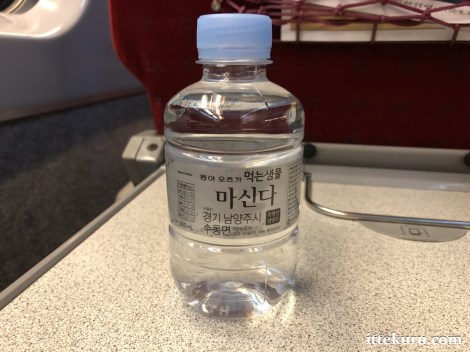In my previous post, we saw what it’s like to travel in Standard (Economy) Class on the KTX from Suncheon to Yeosu. Today, we’ll upgrade ourselves to the posh First Class cabin for our return journey.
Note: The journey described in this travel report took place on 26 January 2020. Fares, timetables, train hardware, station facilities and other details may change anytime without prior notice.
OVERVIEW
Country : Republic of Korea (South Korea)
Railway company : KORAIL
Service type : High-Speed Rail
Service name/designation : KTX 716
Rolling stock : KTX–I
Travel class : First
Line used : Jeolla Line
Origin : Yeosu Expo Station (dep. 15:00)
Destination : Suncheon Station (arr. 15:18)
Journey time : 18 minutes
Fare : 13,200 won
Date of journey : Sunday, 26 January 2020
ROUTE
This journey – like the one before it – covered only a very small (34.8 km) portion of KORAIL’s Jeolla Line, which stretches for 180.4 km from Yeosu Expo station in the south to Iksan Station in the north. Many KTX services run all the way to/from Seoul (more than 200 km further north from Iksan) by way of the Honam and Gyeongbu Lines, offering seamless connections for passengers who need to travel between the Korean capital and the Jeolla region.
THE EXPERIENCE
Step 1: Make your way to the station
My starting point was Yeosu Expo Station (여수엑스포역), the southern terminus of KORAIL’s Jeolla Line.
Located on the edge of Yeosu’s scenic port district, the station directly faces the sprawling convention centre where Expo 2012 was held. Downtown Yeosu sits far to the west of here, making this KTX stop somewhat less than convenient for travellers heading to the old city centre. That said, I suspect most day-trippers will be interested mainly in the newer attractions built around the nearby harbour, and buses or taxis can provide the necessary connections to anything further afield.
Let’s head inside and move on to the next step.
Step 2: Buy your train ticket
Ticket machines are available at major train stations. The catch: not all of them take cash, and the ones that accept cards might read only plastic issued locally (i.e., by Korean banks or Korean branches of foreign banks).
For my part, I queued up at a manned ticket window to book passage on the next available train.
13,200 won got me a seat to Suncheon Station in the First Class compartment of the KTX 716, scheduled to depart at 15:00. Standard (Economy) Class would have cost me just 8,400. Whether the premium is justified by the perks of travelling First is, of course, purely a matter of personal judgement – I for one think it’s well worth the small additional expense.
Step 3: Relax in the station whilst waiting for your train
Yeosu Expo Station is a modern, spacious transport facility. Perhaps too spacious, considering that it’s a relatively quiet stop in terms of passenger traffic. Even with the uptick in volume due to the long Seollal weekend, it didn’t seem the slightest bit congested when I passed through.
Of course, it’s easy to forget that the station was originally built to handle the large numbers of visitors drawn to Yeosu during Expo 2012. With the Expo long over and the former event grounds mostly empty – though still something of a tourist draw – I suppose it’s not surprising that this facility seems a wee bit underutilised.
Step 4: Head for the platform
The concourse is located on the same level as the lobby. Just walk through the doors and head for your train’s designated platform.
The departure platform isn’t printed on the ticket. However, if you buy yours from a manned counter, the agent will (in my experience) write that information down for you.
Step 5: Board your train
Today’s service was operated using a KTX-I train. Derived from the French TGV Réseau, this type is the first generation of high-speed rolling stock used on the KORAIL network, with markedly different exteriors and interiors from those of the newer second-generation KTX-Sancheon series.
Here’s another picture of our train (the one on the right) taken just after our arrival at Yeosu Expo Station. The one on the left is a KTX-Sancheon.
The first 12 KTX-I trainsets were built in France by Alstom. Another 34 were produced in Korea by Rotem, under licence from the original manufacturer. Today’s train, set number 16 (built in 2002), belongs to that second group.
Let’s hop aboard! Mind the platform gap – but not to worry, that’s what the retractable step below the door is for.
Now for a quick look round the vestibule area. You’ll find some luggage racks, a selection of reading materials, and simplified diagrams showing which cars you’ll find various facilities/amenities in.
Step 6: Locate your seat and settle in
Your assigned car and seat number are shown on your ticket. First Class compartments are fitted with 3 seats to a row, singles on one side of the aisle and pairs on the other. This contrasts with the tighter 4-abreast configuration used in Standard (Economy) Class, as described in my previous post.
Here’s something to bear in mind when taking the Standard Class car of a KTX-I train. Unlike the First Class seats on the same train – or all seats, regardless of class, on the newer KTX-Sancheon – not all Standard Class seats on the KTX-I face the direction of travel. About half of the rows in a typical Standard Class compartment are permanently orientated towards one direction, and the other half in the direction opposite. Both halves converge in the middle to form two four-person sets of “family seats”, with a table between the facing rows.
If you’re not keen on travelling “backwards”, it might be a good idea to advise the counter staff of your preference when purchasing a ticket. Of course, this won’t be a problem if you’ve booked a First Class seat on a KTX-I (or any class of seat on a KTX-Sancheon), as the seats are mechanically rotated to face the direction of travel.
Step 7: Enjoy the ride
First Class passengers are offered complimentary snacks and bottled water. On the newer KTX-Sancheon trains, the water is served directly at your seat together with the snack package. But on older KTX-I trains like this one, you’ll need to fetch the water yourself from a vending machine next to the First Class compartment. (Note: it’s still free; the machine won’t require you to insert cash.)
If the in-seat magazine (mostly in Korean) doesn’t suit, just lean back and enjoy a video or some music through your personal electronic device. A few seats are located next to wall-mounted outlets, but not all rows are fitted with these.
You might also draw the window shade or adjust the ventilation to improve comfort.
And there we are. Now all that’s left is to sit back, relax, and take in the experience as the train bears us towards our destination at high speed.
Cheerio.


























Pingback: Rail Report: Standard Class on the KTX from Suncheon Station to Yeosu Expo, South Korea | Within striking distance·